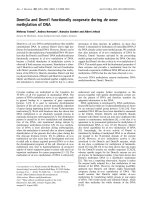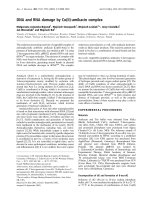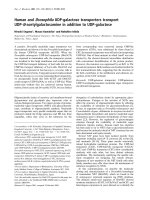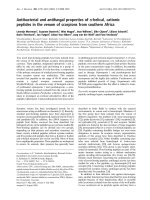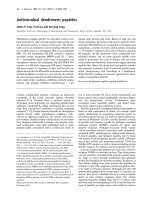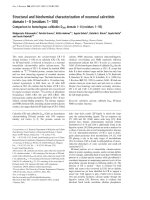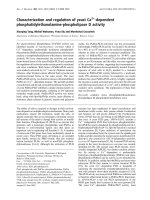Báo cáo y học: "Antimicrobial and antioxidant activities of Cortex Magnoliae Officinalis and some other medicinal plants commonly used in South-East Asia" doc
Bạn đang xem bản rút gọn của tài liệu. Xem và tải ngay bản đầy đủ của tài liệu tại đây (695.64 KB, 10 trang )
BioMed Central
Page 1 of 10
(page number not for citation purposes)
Chinese Medicine
Open Access
Research
Antimicrobial and antioxidant activities of Cortex Magnoliae
Officinalis and some other medicinal plants commonly used in
South-East Asia
Lai Wah Chan
1
, Emily LC Cheah
1
, Constance LL Saw
2
, Wanyu Weng
1
and
Paul WS Heng*
1
Address:
1
Department of Pharmacy, Faculty of Science, National University of Singapore, 18 Science Drive 4, Singapore 117543 and
2
Center for
Cancer Prevention Research, Department of Pharmaceutics, Ernest Mario School of Pharmacy, Rutgers, State University of New Jersey, 160
Frelinghuysen Road, Piscataway, New Jersey 08854, USA
Email: Lai Wah Chan - ; Emily LC Cheah - ; Constance LL Saw - ;
Wanyu Weng - ; Paul WS Heng* -
* Corresponding author
Abstract
Background: Eight medicinal plants were tested for their antimicrobial and antioxidant activities.
Different extraction methods were also tested for their effects on the bioactivities of the medicinal
plants.
Methods: Eight plants, namely Herba Polygonis Hydropiperis (Laliaocao), Folium Murraya Koenigii
(Jialiye), Rhizoma Arachis Hypogea (Huashenggen), Herba Houttuyniae (Yuxingcao), Epipremnum
pinnatum (Pashulong), Rhizoma Typhonium Flagelliforme (Laoshuyu), Cortex Magnoliae Officinalis
(Houpo) and Rhizoma Imperatae (Baimaogen) were investigated for their potential antimicrobial and
antioxidant properties.
Results: Extracts of Cortex Magnoliae Officinalis had the strongest activities against M. Smegmatis,
C. albicans, B. subtilis and S. aureus. Boiled extracts of Cortex Magnoliae Officinalis, Folium Murraya
Koenigii, Herba Polygonis Hydropiperis and Herba Houttuyniae demonstrated greater antioxidant
activities than other tested medicinal plants.
Conclusion: Among the eight tested medicinal plants, Cortex Magnoliae Officinalis showed the
highest antimicrobial and antioxidant activities. Different methods of extraction yield different
spectra of bioactivities.
Background
Some medicinal plants used in traditional Chinese medi-
cine are effective in treating various ailments caused by
bacterial and oxidative stress. As new drug-resistant bacte-
ria strains emerge, especially methicillin-resistant Staphy-
lococcus aureus and vancomycin-resistant enterococci, new
drugs or adjuvants have been actively searched in medici-
nal plants [1-3]. New antioxidants such as plant phenolics
[4-7] are sought for general health maintenance, anti-
aging and chemoprevention.
Eight medicinal plants, namely Herba Polygonis Hydropi-
peris (Laliaocao), Folium Murraya Koenigii (Jialiye), Rhizoma
Arachis Hypogea (Huashenggen), Herba Houttuyniae (Yux-
Published: 28 November 2008
Chinese Medicine 2008, 3:15 doi:10.1186/1749-8546-3-15
Received: 4 February 2008
Accepted: 28 November 2008
This article is available from: />© 2008 Chan et al; licensee BioMed Central Ltd.
This is an Open Access article distributed under the terms of the Creative Commons Attribution License ( />),
which permits unrestricted use, distribution, and reproduction in any medium, provided the original work is properly cited.
Chinese Medicine 2008, 3:15 />Page 2 of 10
(page number not for citation purposes)
ingcao), Epipremnum pinnatum (Pashulong), Rhizoma Typho-
nium Flagelliforme (Laoshuyu), Cortex Magnoliae Officinalis
(Houpo) and Rhizoma Imperatae (Baimaogen) were tested
for their potential antimicrobial and antioxidant proper-
ties. They have been long been used in treating of various
infectious diseases, e.g. skin/wound infections, fever,
cough and digestive ailments (Table 1, [8-33]).
The traditional method for Chinese medicine preparation
is to boil the medicinal plants in water for 20 minutes to
one hour. The present study aims to test the effectiveness
of traditional herb preparation methods for antimicrobial
and antioxidant treatments.
Methods
Materials
Selection of plants
The rationales behind the selection of these eight plants
are as follows. (1) They are commonly used in Asia. (2)
They have long been used as medicinal plants. (3) They
Table 1: Ethnomedicinal uses and properties of the selected plants
Latin pharmaceutical name/
Plant scientific name/Family/
Voucher specimen no.
Vernacular/pinyin names Ethnomedicinal uses Properties
Herba Polygonis Hydropiperis/
Persicaria hydropiper (L.)
a
Spach/
Polygonaceae/001-CS0807
Laksa plant/Laliaocao Used as a condiment. Also
employed as a stomachic and
aphrodisiac. Externally, the
crushed leaves or juice are used to
treat skin conditions such as
ringworms, scabies, boils,
abscesses, carbuncles, ulcers or
bites of snakes, dogs or insects
Antioxidant [8-10]
Folium Murraya Koenigii/Murraya
koenigii Spreng./Rutaceae/002-
CS0807
Curry leaves/Jialiye Used as a condiment. Treatment
of piles, inflammation, itching, fresh
cuts, dysentery, vomiting, burses
and dropsy
Reducing halitosis [11], antioxidant
[12], antimicrobial [13], antifungal
[14], antihyperglycemic and
antihyperlipidemic properties [15]
Rhizoma Arachis Hypogea/Arachis
hypogaea L./Leguminosae/003-
CS0807
Groundnut/Huashenggen Treatment of insomnia and
strengthening of bones
Antifibrinolytic [16]
Herba Houttuyniae/Houttuynia
cordata Thunb./Saururaceae/004-
CS0807
Chinese houttuynia or chameleon
plant/Yuxingcao
Detoxification, treatment of
infection, removing toxic heat,
promoting drainage of pus and
urination
Anti-Severe Acute Respiratory
Syndrome (SARS) [17]. Prevention
of urinary infection, modulation of
neutrophils and monocytes,
inhibition of respiratory bacteria
[18,19]. Anti-inflammatory activity
[20]. Virucidal effects on herpes
simplex virus type 1 and 2,
influenza virus, and human
immunodeficiency virus type 1
[21,22]
Epipremnum pinnatum (L.) Engl./
Araceae/005-CS0807
Dragon tail/Pashulong Detoxification, removes toxic
heat, tendonitis, fractures, burns,
carbuncles, sores, redness
Cytotoxicity against cancers cells
[23], immuno-modulating [24]
Rhizoma Typhonium Flagelliforme/
Typhonium flagelliforme (Lodd.)
Blume/006-CS0807
Rodent tuber/Laoshuyu Treatment of cough, asthma,
nausea and cancers
Relieving cough, eliminating
phlegm, asthmatic, analgesia, anti-
inflammation, sedation and
cytotoxic activities [25-28]
Cortex Magnoliae Officinalis/
Magnolia biloba (Rehder & E. H.
Wilson) Cheng/Magnoliaceae/007-
CS0807
Magnolia/Houpo A tonic to improve general well-
being, also used to treat cough,
diarrhea, allergic rhinitis and
phlegm
Alleviateing menopausal symptoms
[29], brochial asthma [30,31],
active against Propionibacterium
acnes and Propionibacterium
granulosum [32], antimicrobial and
cytotoxic activities [33,34]
Rhizoma Imperatae/Imperata
cylidrica (L.) Beeuv. var. major
(Nees) C.E. Hubb/Gramineae/008-
CS0807
Lalang/Baimaogen Wound-healing, diuretic, anti-
inflammatory and antipyretic
agents
Neuroprotective,
immunostimulating effects [35]
a
Persicaria hydropiper (L.) is synonymous with Polygonum hydropiper (L.). Persicaria hydropiper (L.) and Persicaria odoratum (L.) are commonly used
interchangeably in literature while they are two distinct species. Efforts were made to identify the species of laksa plants used in the study. The plant
was probably Persicaria hydropiper (L.). A specimen of the plant has been deposited in the National University of Singapore Herbarium for future
reference.
Chinese Medicine 2008, 3:15 />Page 3 of 10
(page number not for citation purposes)
are abundant in the market. (4) Their daily applications
have not been documented (except Cortex Magnoliae Offic-
inalis which served as a positive control for its antimicro-
bial activity against S. aureus). The fresh juices of some of
the plants were traditionally used as fresh poultices to
treat some skin conditions (Table 1).
Plant materials
Cortex Magnoliae Officinalis from Zhejiang, China was pur-
chased from WHL Ginseng & Herbs (Singapore), while all
other plants were purchased from a herbal vendor in Out-
ram Park wet market in Singapore. Cortex Magnoliae Offic-
inalis and Rhizoma Imperatae were authenticated by the
Institute of Medicinal Plant Development of the Chinese
Academy of Medical Sciences (China), while the rest were
authenticated by the Herbarium of the Singapore Botanic
Gardens (Singapore). The voucher specimens for each
plant were preserved under the reference number 001-
CS0807 to 008-CS0807 at the Herbarium of the National
University of Singapore, Raffles Museum of Biodiversity
Research and the Department of Biological Sciences of the
National University of Singapore (Table 1).
Chemicals
2,2-diphenyl-1-picryl-hydrazyl (DPPH), magnolol,
honokiol (99.9%) and quercetin were purchased from
Sigma Aldrich (USA).
Solvents
Absolute ethanol (99.9%, Far East Distiller, Singapore)
was diluted with water to produce 80% (v/v) solution of
ethanol for extraction. De-ionized water was used for
extraction (by boiling and maceration), reconstitution
and dilution where appropriate. Methanol (analytical
grade, Tedia, USA) was used for reconstitution and dilu-
tion in the DPPH assay.
Microorganisms, growth media and standard antibiotic discs
Four strains of bacteria and one strain of yeast were used
for antimicrobial tests. The test bacteria included Gram-
positive Staphylococcus aureus (ATCC 6538P) and Bacillus
subtilis (ATCC 6633), Gram-negative Pseudomonas aerugi-
nosa (ATCC 9027) and acid-fast Mycobacterium smegmatis
(ATCC 14468). Candida albicans (ATCC 2091) was used as
a representative of yeast. All microorganisms were pur-
chased in the form of inoculation loops from Oxoid (UK).
Nutrient broth with agar and Sabouraud dextrose agar
(Acumedia, USA) were used for the cultivation of bacteria
and yeast respectively. Mueller Hinton agar (France) was
used in antimicrobial screening.
Standard antibiotic discs (diameter 6 mm) used in this
study were: methicillin 5 μg, tetracycline 30 μg, carbenicil-
lin 100 μg and streptomycin 10 μg. In our preliminary
studies, these antibiotics were found to be active against
Staphylococcus aureus, Bacillus subtilis, Pseudomonas aerugi-
nosa and Mycobacterium smegmatis respectively. All stand-
ard antibiotic discs were purchased from Oxoid (UK).
Disc containing chlorhexidine which was active against
Candida albicans, were prepared by loading dry sterile filter
paper discs (Whatman No. 54, diameter 5.5 mm) with
chlorhexidine solution to give a total weight of approxi-
mately 100 μg of chlorhexidine per disc. The impregnated
discs were dried overnight at 40°C and stored (less than
five days) in a desiccator until use.
Preparation of plant materials prior to extraction
The fresh plants were kept in a refrigerator for no longer
than three days prior to extraction. Cortex Magnoliae Offic-
inalis was dried in a cool, dark room (room temperature
19°C, relative humidity 60%) and subsequently stored in
a drum with silica gel desiccants until use. Before extrac-
tion, the plants were cut into 1 cm pieces with pruning
scissors, except Rhizoma Imperatae and Cortex Magnoliae
Officinalis which were milled into fine powder using a pul-
verizer mill (Christy & Norris, UK). Triplicate prepara-
tions of each sample were carried out.
Extraction and preparation of crude extracts
Boiling, maceration and blending
Two and a half grams of Folium Murraya Koenigii, Typho-
nium flagelliforme aerial parts and 5 g of the other plant
materials, were each extracted with 200 ml of water or eth-
anol. Three extraction methods were employed: (1) boil-
ing in water for 1 hour, (2) maceration for 24 hours in
water or (3) 80% (v/v) ethanol at room temperature.
Herba Houttuyniae was extracted using an additional
extraction method that involved boiling in water for 20
minutes [36]. Additional extraction experiments were car-
ried out on aqueous plant extracts that showed promising
antimicrobial activities. Boiling time was limited to 20
minutes to minimize heat exposure. Blending-maceration
was used as a non-heat extraction method with cell rup-
ture mechanism. Blending was performed with a labora-
tory blender (Waring Commercial, USA) for one minute,
followed by a pause and then blending for an additional
minute. Maceration in de-ionized water for one hour was
performed. Coarse particles were removed using What-
man No. 1 filter paper (Whatman International, UK)
before evaporation.
Extraction of fresh juices
Fresh juices of Herba Houttuyniae, Epipremnum pinnatum
stem and Typhonium flagelliforme aerial parts and rhizomes
were prepared in a mortar, wrapped in linen cloth and
squeezed for the juices. Coarse particles were removed
using Whatman No. 1 filter paper before evaporation.
Chinese Medicine 2008, 3:15 />Page 4 of 10
(page number not for citation purposes)
Evaporation of extracts
The plant extracts were evaporated to dryness under
reduced pressure at 40°C for ethanol extracts and 60°C
for water extracts and fresh juices in a rotary evaporator
(Model N1000, Eyela, Japan). The solid content of the
extract was weighed. The dried extracts were stored in a
freezer at -20°C.
Characterization of plant extracts
The crude and dried extracts were characterized by their
odor, appearance and texture. The weights of the dried
extracts were also determined.
Determination of antimicrobial activities
Preparation of extract- and standard-loaded discs
Filter paper discs (Grade 54, diameter 5.5 mm, Whatman
International, UK) were autoclaved at 121°C for 20 min-
utes and oven-dried at 40°C overnight. Plant extracts were
diluted with the same extraction solvent to 50 μg/μl. Each
diluted solution (2 μl, equivalent to 100 μg of the dried
extract) was loaded on a sterile filter paper disc. All
impregnated discs were dried in sterile glass Petri dishes
placed in an oven at 40°C overnight. The discs were then
allowed to condition to room temperature before use in
the antimicrobial test. Solutions in methanol (5 μg/μl)
were prepared for magnolol and honokiol respectively
and a 1:1 solution of the two compounds (2.5 μg/μl) was
made. 2 μl of the honokiol, magnolol or 1:1 solutions
were loaded onto paper discs which were then left to air-
dry. These standard-loaded discs were freshly prepared
before the antimicrobial screening experiments.
Screening of antimicrobial activities of plant extracts
The antimicrobial activities of the extracts were deter-
mined by the Kirby-Bauer agar diffusion method accord-
ing to NCCLS standards [37,38]. Sterilized molten agar
(20 ml) was dispensed to each sterile disposable Petri dish
(diameter 9 cm) and allowed to solidify. Mueller Hinton
agar was used for bacteria and Sabouraud dextrose agar for
yeast. Microbial suspension (200 μl) containing approxi-
mately 3 × 10
6
CFU was spread evenly onto the surface of
the solidified medium. The plates were allowed to dry for
15 minutes before the test discs were placed at equidis-
tance from each other. Each plate consisted of one stand-
ard antibiotic disc and three other discs impregnated with
various extracts.
After standing for 30 minutes, the Petri dishes were incu-
bated in an inverted position at 37°C for 18 to 24 hours
for bacteria and 24°C for 48 to 72 hours for yeasts. The
diameters of the zone of inhibition (ZIH), defined by the
clear area devoid of growth, was measured twice. The anti-
microbial activities were determined by the ratio of the
ZIH diameters of the extracts to that of the standard anti-
biotic in the same Petri dish, whereby a higher ratio indi-
cates a more potent extract.
Determination of antioxidant activity
Antioxidant activities of the extracts were determined with
2,2-diphenyl-1-picryl-hydrazyl (DPPH) assay [39]. The
free radical, DPPH, served as the model oxidizing agent to
be reduced by the antioxidant present in the extracts. The
amount of dried extract subject to DPPH assay was 100
μg, the same amount used for antimicrobial screening.
The dried extract was dissolved in 1.56 ml of methanol
and mixed with 40 μl of 2 mM DPPH dissolved in meth-
anol to make up a total volume of 1.6 ml in each polyeth-
ylene microfuge tubes. The final solution was allowed to
react in dim light for 15 minutes. It was then centrifuged
(4000 rpm; 1165 × g, Kubota 2100 Centrifuge, Japan) for
five minutes. The absorbance of the supernatant was
measured at 517 nm with a UV spectrophotometer (Gene-
sys 10 UV, ThermoSprectronic, USA). The tests were car-
ried out in triplicates. The DPPH radical scavenging
activity was calculated with the following formula:
DPPH radical scavenging activity (%) = [A
0
-(A
1
-A
S
)]/A
0
×
100
Where A
0
is the absorbance of the control solution con-
taining only DPPH after incubation; A
1
is the absorbance
in the presence of plant extract in DPPH solution after
incubation; and A
s
is the absorbance of sample extract
solution without DPPH for baseline correction arising
from unequal color of the sample solutions (optical blank
for A
1
).
Data and statistical analysis
Data are expressed as mean ± standard deviation (SD) of
triplicates. Two-way ANOVA was used to analyze the
effect of different plant materials and extraction methods
on the extraction yields and DPPH radical scavenging
activity while one-way ANOVA was performed to deter-
mine the effect of streptomycin, honokiol, magnolol and
honokiol-magnolol combination on M. smegmatis. Both
tests employed Bonferroni post hoc analysis. Student's t-
test was used to compare antimicrobial activity of the
extracts against the standard antibiotic. All statistical anal-
yses were conducted with SPSS software (v.12, SPSS, USA)
at a significance level of 0.05.
Results and discussion
Physical characterization of herbal extracts
Extraction yields
The extraction yields obtained from different extraction
methods were analyzed with two-way ANOVA and Bon-
ferroni post hoc analysis. Among the 11 experimental
groups, Rhizoma Imperatae produced the highest yields (P
= 0.001) regardless of extraction methods, followed by
Chinese Medicine 2008, 3:15 />Page 5 of 10
(page number not for citation purposes)
Cortex Magnoliae Officinalis (Figure 1). These two dry
herbs were processed through comminution producing
fine powder prior to extraction. The reduced particle size
decreases the internal mass resistance for compounds to
traverse through the plant matrix and increases the spe-
cific surface area for extraction. The extraction yields
obtained from boiling were higher than those from other
extraction methods.
Boiling Herba Houttuyniae aerial parts in water for 20 min-
utes or one hour produced comparable yields (P = 1.000).
For Herba Polygonis Hydropiperis, Folium Murraya Koenigii
and Cortex Magnoliae Officinalis, a shorter boiling time of
20 minutes was shown to be comparable to a boiling time
of 60 minutes (P = 0.061, 0.053 and 0.798 respectively).
While results from blending/maceration varied, this
Solid content of extracts obtained by different methods*Figure 1
Solid content of extracts obtained by different methods*. *Error bars represent standard deviation (n = 3).
Chinese Medicine 2008, 3:15 />Page 6 of 10
(page number not for citation purposes)
method was as efficient as the boiling method in terms of
solid yields (P = 0.261) of Folium murraya koenigii.
Organoleptic properties
The color, texture and odor of the plant extracts were char-
acterized (Additional file 1). The ethanolic extracts were
better than corresponding aqueous extracts in retaining
the natural fragrances of the plants. This may be due to the
preservative ability of ethanol (i.e. reducing breakdown of
organic compounds by microorganisms), its enhanced
extraction capability (i.e. more fragrant components
extracted) or a combination of both. Extracts obtained by
boiling generally appeared darker and more turbid than
those obtained by maceration. The solid content by boil-
ing was higher than that by maceration (Figure 1). Boiling
is more likely to damage the plant cell membrane and cell
wall which act as natural filters to keep larger extraneous
compounds within the cell.
Antimicrobial activities
Dried herbal extracts
Among all the extracts studied, the 100 μg of the ethanolic
extract of Cortex Magnoliae Officinalis loaded on the filter
paper disc demonstrated the most robust antimicrobial
activities against S. aureus, B. subtilis, M.smegmatis and C.
albicans, equivalent to at least 50% of the activities of the
standard antibiotics. Among the test organisms, it was
most active against M.smegmatis, 20% more than the
standard antibiotic, streptomycin 10 μg (Student's t-test, P
= 0.001) (Table 2). The boiled extract of Cortex Magnoliae
Officinalis had comparable antimicrobial activities to
those of streptomycin 10 μg (Student's t-test, P = 0.279).
These data suggest that Cortex Magnoliae Officinalis may be
a potential agent to treat infections caused by M. smegma-
tis and Mycobacterium tuberculosis [40]. It was reported that
magnolol and honokiol exhibited antibacterial activities
against methicillin-resistant S. aureus and vancomycin-
resistant enterococci [33], Propionibacterium sp [32] and
periodontal pathogens [34]. Therefore, disk diffusion test
was carried out on magnolol and honokiol individually
and in combination (Table 2). The one way ANOVA on
the four treatment groups namely streptomycin,
honokiol, magnolol and combination of magnolol and
honokiol (1:1) demonstrated a significant difference
between groups (P = 0.001). Bonferroni post-hoc test
showed that honokiol and magnolol had comparable
activities (P = 1.000) against M. smegmatis, accounting for
83.58 ± 3.06% (P = 0.015) and 82.09 ± 6.51% (P = 0.006)
of those of Streptomycin 10 μg respectively. In terms of
antibacterial activities, the combination of magnolol and
honokiol (1:1) was comparable to the reference antibiotic
(P = 1.000) but higher than either magnolol (P = 0.007)
or honokiol (P = 0.017) alone. These results suggest a new
discovery of synergism between magnolol and honokiol.
Ethanolic extract of Folium Murraya Koenigii and boiled
extract of Herba Polygonis Hydropiperis showed 80% and
50% of the activities of streptomycin 10 μg against M.
smegmatis respectively. These extracts also exhibited anti-
microbial activities against S. aureus and B. subtilis. Addi-
tionally, the boiled extract of Herba Polygonis Hydropiperis
was active against C. albicans. Boiling was essential for the
active principles to be removed from the laksa plant, as
blended and water macerated extracts showed little anti-
microbial activities (Table 3). The duration of the boiling
process also affected the antimicrobial activities of laksa
plant, whereby herbs boiled for 20 minutes were more
active against S. aureus and M. smegmatis. The aerial parts
of Herba Houttuyniae and rodent tuber were only active
against B. subtilis and S. aureus respectively. The leaves and
Rhizoma Arachis Hypogea, Rhizoma Imperatae, Rhizoma
Typhonium Flagelliforme, and the leaves and stems of Epi-
premnum pinnatum did not show any antimicrobial activi-
ties.
An extract with a high yield, however, does not necessarily
have high antimicrobial activities. For example, Rhizoma
Imperatae whose yields topped all extraction methods, did
not show any antimicrobial activities (Figure 1 and Table
3).
Fresh herbal extracts
The fresh juices of Herba Houttuyniae aerial parts, Epiprem-
num pinnatum stems and Rhizoma Typhonium Flagelliforme
Table 2: Inhibition zones of Streptomycin 10 μg, magnolol, honokiol and a 1:1 combination of magnolol and honokiol
Compound tested Inhibition zone
(mm)
Percentage activity of
compound in
comparison to
Streptomycin 10 μg (%)
P-value
(one-way ANOVA with Bonferroni post hoc test)
Streptomycin 10 μg Magnolol Honokiol Magnolol and
Honokiol (1:1)
Streptomycin 10 μg 34.67 ± 1.75 100 - - - -
Magnolol 10 μg 27.50 ± 2.18 82.09 ± 6.51 0.006 - -
Honokiol 10 μg 28.42 ± 1.04 83.58 ± 3.06 0.015 1.000 - -
Magnolol and
Honokiol (1:1) 10 μg
34.50 ± 2.00 94.52 ± 5.48 1.000 0.007 0.017 -
Chinese Medicine 2008, 3:15 />Page 7 of 10
(page number not for citation purposes)
were tested for their folkloric use to treat wounds and var-
ious skin ailments (Table 1). All these fresh juices dis-
played some activities (less than 30% of the activity of
methicillin 5 μg) against S. aureus. However, they were
inactive against the rest of the test organisms. While the
yields of fresh juices were lower than those of other extrac-
tion methods, antibacterial activities against S. aureus
implied reduced degradation of the bioactive principles.
Among all extracts, only the fresh juices of Rhizoma Typho-
nium Flagelliforme and Epipremnum pinnatum leaves and
stems possessed antimicrobial activities (Table 2), sug-
gesting that the antimicrobial components were unstable
and destroyed by boiling and/or maceration. However,
the extract of aerial parts of Rhizoma Typhonium Flagelli-
forme by maceration in water showed 20% of the activities
of methicillin 5 μg against S. aureus. This finding suggests
the antimicrobial potential of rodent tuber is beyond the
ethnomedicinal use of the rhizomes.
The strongly aromatic plant materials, such as Herba Poly-
gonis Hydropiperis, Folium Murraya Koeniggi and Cortex
Table 3: Antimicrobial activities of various plant extracts (100 μg of the extract per loaded disc)
Zone of inhibition (extract)/Zone of inhibition (standard)
S. aureus B. subtilis Ps. Aeruginosa M. smegmatis C. albicans
Plant name (Latin) Plant part Code Ave SD Ave SD Ave SD Ave SD Ave SD
Arachis hypogea Leaves PLB - - - - -
PLW - - - - -
PLE - - - - -
Rhizomes PRLB - - - - -
PRLW - - - - -
PRLE - - - - -
Epipremnum pinnatum Leaves RB - - - - -
RW - - - - -
RE - - - - -
Stems RSB - - - - -
RSW - - - - -
RSE - - - - -
Stems (fresh juices) RF 0.29 0.01 - - - - - - - -
Periscaria hydropiper Aerial parts (leaves & stems) LB 0.30 0.02 0.32 0.02 - - 0.50 0.00 0.50 0.00
LW - - - - -
LE 0.25 0.02 - - - - - - - -
LM - - - - -
Imperata cylindrica Rhizomes AB - - - - -
AW - - - - -
AE - - - - -
Houttuynia cordata Aerial parts (leaves & stems) FSB - - - - - - - - - -
FB - - 0.30 0.00 - - - - - -
FW - - - - -
FE - - - - -
Aerial parts (fresh juices) FF 0.29 0.04 - - - - - - - -
Murraya koenigii Leaves CB - - 0.30 0.00 - - - - - -
CW - - - - -
CE 0.49 0.01 0.35 0.03 - - 0.77 0.05 - -
CM 0.20 0.02 - - - - - - - -
Magnolia officinalis Barks MB 0.35 0.06 0.37 0.00 - - 1.07 0.06 - -
MW 0.30 0.01 0.32 0.02 - - 0.71 0.05 - -
ME 0.50 0.01 0.61 0.03 - - 1.23 0.05 0.89 0.06
MM 0.19 0.04 - - - - 0.24 0.08 - -
Typhonium flagelliforme Aerial parts (leaves & stems) YB - - - - - - - - - -
YW 0.22 0.01 - - - - - - - -
YE - - - - -
Rhizomes YRB - - - - - - - - - -
YRW - - - - -
YRE - - - - -
Leaves (fresh juices) YF 0.28 0.06 - - - - - - - -
Rhizomes (fresh juices) YRF 0.27 0.02 - - - - - - - -
Roots (fresh juices) YRR 0.23 0.02 - - - - - - - -
Chinese Medicine 2008, 3:15 />Page 8 of 10
(page number not for citation purposes)
Magnoliae Officinalis, exhibited a broad spectrum of anti-
microbial activities. One possible reason is the presence of
essential oils and active polyphenolic compounds which
possess antimicrobial activities. Among the extracts of
Cortex Magnoliae Officinalis, the ethanolic extract demon-
strated the strongest activities against S. aureus, B. subtilis,
M. smegmatis and C. albicans. The active biphenol com-
pounds in Cortex Magnoliae Officinalis (honokiol and
magnolol) are poorly water soluble and extracted more
efficiently by ethanol than water.
None of the extracts, however, inhibited Ps. aeruginosa.
Both S. aureus and B. subtilis are Gram-positive, while Ps.
aeruginosa is Gram-negative and has an outer lipid mem-
brane [41]. The results suggest that the antimicrobial com-
pounds in the extracts were unable to penetrate this lipid
membrane to exert their effects inside a cell. This specula-
tion will require further experiments to confirm.
Antioxidant activities
The antioxidant activities of the dried extracts and fresh
juices are presented in Figure 2. All tested plants possessed
some DPPH radical scavenging activities to a certain
extent. While Cortex Magnoliae Officinalis, stems and
leaves of dragon tail, laksa aerial parts, Herba Houttuyniae
aerial parts and curry leaves showed high activities, rodent
tuber rhizomes and aerial parts showed low activities.
The high antioxidant activities of the boiled and ethanolic
extracts of the leafy materials were probably due to the
extracted tannins and photosynthetic pigments. Cortex
Magnoliae Officinalis is a rich source for antioxidative com-
pounds, such as biphenols, polyphenols and tannins
[42,43]. Lo et al. found that the antioxidant effects of mag-
nolol and honokiol isolated from Cortex Magnoliae Offici-
nalis were 1000 times higher than those of alpha-
tocopherol [44]. Earlier studies confirmed that several
naturally occurring dietary phytochemicals, such as iso-
thiocyanates, curcumin and Epigallocatechin-3-gallate,
possessed cancer preventive properties [45,46].
Boiled extracts showed greater antioxidant activities than
those of other extraction methods (P = 0.001). Antioxi-
dant compounds in leafy materials are generally located
in conduit structures called the apoplast and symplast
[47-49]. Maceration alone is not sufficient to extract these
compounds from the structures. The application of heat,
in the boiling process, facilitates cell rupture and leaching,
Antioxidant activities of extracts tested by DPPH assay*Figure 2
Antioxidant activities of extracts tested by DPPH assay*. *Error bars represent standard deviations (n = 3).
Chinese Medicine 2008, 3:15 />Page 9 of 10
(page number not for citation purposes)
thereby improving the mass transfer of these compounds
from the storage organs into the boiling water. Ethanol
may partially solubilize the membranes of the plant cells
and storage organs, helping leach the chemicals away.
However, maceration in 80% ethanol took over 24 hours
and exposed the extracts to oxidative and hydrolytic deg-
radation. This may explain the relatively low antioxidant
activities of some ethanolic extracts.
The extracts of Cortex Magnoliae Officinalis, Herba Houttuy-
niae aerial parts and Folium Murraya Koenigii (ethanolic
extract) had similar high DDPH radical scavenging activi-
ties (>85%) but markedly different antimicrobial proper-
ties (Figure 2 and Table 3). The results suggest that the
active components for antimicrobial and antioxidant
activities do not share common biochemical pathways.
Conclusion
The present study discovered that (a) the ethanolic extract
of Cortex Magnoliae Officinalis had 20% greater antimicro-
bial activities against M. smegmatis than streptomycin; (b)
the boiled extract of Cortex Magnoliae Officinalis demon-
strated comparable activities to streptomycin (c) the syn-
ergism of magnonol and honokiol had comparable effects
to those of streptomycin; (d) the aerial parts of rodent
tuber had antimicrobial activities against S. aureus.
Among the tested 107 extracts, Cortex Magnoliae Officinalis
had (1) potent antimicrobial activities against S. aureus, B.
subtilis, M. smegmatis and C. albicans and (2) highest anti-
oxidant activities in DPPH assay regardless extraction
methods. Cortex Magnoliae Officinalis is likely a potential
medicinal plant resource for developing effective antimi-
crobials and antioxidants.
Competing interests
The authors declare that they have no competing interests.
Authors' contributions
LWC and PWSH conceived the research design and super-
vised the manuscript preparation. WYW, ELCC and CLLS
performed all extractions, antimicrobial and antioxidant
studies as well as statistical analyses. All authors read and
approved the final version of the manuscript.
Additional material
Acknowledgements
This work was funded by the Academic Research Fund (R-148-000-055-
112), National University of Singapore. Our appreciation is extended to Ms
Ooi Shing Ming for her assistance in experiments, Prof Baolin Guo, Herbar-
ium of the Institute of Medicinal Plant Development (IMPLAD) of the Chi-
nese Academy of Medical Sciences (Beijing, China) and Ms Serena Lee,
Herbarium of Singapore Botanic Gardens, National Parks Board of Singa-
pore for the authentication of plant materials. ELCC received a postgradu-
ate research scholarship from the National University of Singapore.
References
1. Shahverdi AR, Fakhimi A, Zarrini G, Dehghan G, Iranshahi M: Gal-
banic acid from Ferula szowitsiana enhanced the antibacte-
rial activity of penicillin G and cephalexin against
Staphylococcus aureus. Biol Pharm Bull 2007, 30:1805-1807.
2. Horiuchi K, Shiota S, Hatano T, Yoshida T, Kuroda T, Tsuchiya T:
Antimicrobial activity of oleanolic acid from Salvia officinalis
and related compounds on vancomycin-resistant entero-
cocci (VRE). Biol Pharm Bull 2007, 30:1147-1149.
3. Horiuchi K, Shiota S, Kuroda T, Hatano T, Yoshida T, Tsuchiya T:
Potentiation of antimicrobial activity of aminoglycosides by
carnosol from Salvia officinalis. Biol Pharm Bull 2007, 30:287-290.
4. Kelen M, Tepe B: Chemical composition, antioxidant and anti-
microbial properties of the essential oils of three Salvia spe-
cies from Turkish flora. Bioresour Technol 2008,
99(10):4096-4104.
5. Chua M-T, Tung Y-T, Chang S-T: Antioxidant activities of eth-
anolic extracts from the twigs of Cinnamomum
osmophloeum. Bioresource Tech 2008, 99:1918-1925.
6. Li H-B, Wong C-C, Cheng K-W, Chen F: Antioxidant properties
in vitro and total phenolic contents in methanol extracts
from medicinal plants. LWT – Food Sci Tech 2008, 41:385-390.
7. Soobrattee MA, Bahorun T, Neergheen VS, Googoolye K, Aruoma
OI: Assessment of the content of phenolics and antioxidant
actions of the Rubiaceae, Ebenaceae, Celastraceae, Eryth-
roxylaceae and Sterculaceae families of Mauritian endemic
plants. Toxicology in Vitro 2008, 22:45-56.
8. Peng ZF, Strack D, Baumert A, Subramaniam R, Goh NK, Chia TF,
Tan SN, Chia LS: Antioxidant flavonoids from leaves of Poly-
gonum hydropiper L. Phytochemistry 2003, 62:219-228.
9. Yagi A, Uemura T, Okamura N, Haraguchi H, Imoto T, Hashimoto K:
Antioxidative sulphated flavonoids in leaves of polygonum
hydropiper. Phytochemistry 1994, 35:885-887.
10. Haraguchi H, Hashimoto K, Yagi A: Antioxidative substances in
leaves of polygonum hydropiper. J Agric Food Chem 1992,
40:1349-1351.
11. Math MV, Balasubramaniam P: Curry leaves (Murraya Koenigii
spreng) and halitosis. BMJ (South Asia ED) 2003, 19:211.
12. Nakatani N: Phenolic antioxidants from herbs and spices. Bio-
factors 2000, 13:141-146.
13. Rahman MM, Gray AI: A benzoisofuranone derivative and car-
bazole alkaloids from Murraya koenigii and their antimicro-
bial activity. Phytochemistry 2005, 66:1601-1606.
14. Das KC, Chakraborty DP, Bose PK: Antifungal activity of some
constituents of Murraya koenigii Spreng. Experientia 1965,
21:340.
15. Kesari AN, Kesari S, Singh SK, Gupta RK, Watal G: Studies on the
glycemic and lipidemic effect of Murraya koenigii in experi-
mental animals. J Ethnopharmacol 2007, 112:305-311.
16. Verstraete M, Ruys CA: Double-blind experiments on the effect
of a peanut extract on the bleeding incidence in 92 haemo-
philiacs. Br Med J 1967, 4:453-456.
17. Li S, Wang R, Zhang Y, Zhang X, Layon AJ, Li Y, Chen M: Symptom
combinations associated with outcome and therapeutic
effects in a cohort of cases with SARS. Am J Chin Med 2006,
34:937-947.
18. Wang C: The effects of houttuynia cordata thunb and some
other herbs on human neutrophil and monocyte chemilumi-
nescence. Guangxi Yikedaxue Xuebao 1997, 14:20-22.
19. Wu W: Advances in studies on houttuynia cordata. Zhong-
caoyao 2001, 32:367-368.
20. Lu HM, Liang YZ, Yi LZ, Wu XJ: Anti-inflammatory effect of
Houttuynia cordata injection. J Ethnopharmacol 2006,
104:245-249.
Additional file 1
Organoleptic properties of the plant extracts investigated in this study.
This table is a summary of the organoleptic properties of the plant extracts
investigated in this study, such as color, texture and odor.
Click here for file
[ />8546-3-15-S1.doc]
Publish with BioMed Central and every
scientist can read your work free of charge
"BioMed Central will be the most significant development for
disseminating the results of biomedical research in our lifetime."
Sir Paul Nurse, Cancer Research UK
Your research papers will be:
available free of charge to the entire biomedical community
peer reviewed and published immediately upon acceptance
cited in PubMed and archived on PubMed Central
yours — you keep the copyright
Submit your manuscript here:
/>BioMedcentral
Chinese Medicine 2008, 3:15 />Page 10 of 10
(page number not for citation purposes)
21. Hayashi K, Kamiya M, Hayashi T: Virucidal effects of the steam
distillate from Houttuynia cordata and its components on
HSV-1, influenza virus, and HIV. Planta Med 1995, 61:237-241.
22. Chiang LC, Chang JS, Chen CC, Ng LT, Lin CC: Anti-Herpes sim-
plex virus activity of Bidens pilosa and Houttuynia cordata.
Am J Chin Med 2003, 31:355-362.
23. Tan ML, Muhammad TS, Najimudin N, Sulaiman SF: Growth arrest
and non-apoptotic programmed cell death associated with
the up-regulation of c-myc mRNA expression in T-47D
breast tumor cells following exposure to Epipremnum pin-
natum (L.) Engl. hexane extract. J Ethnopharmacol 2005,
96:375-383.
24. Wong KT, Tan BK: In vitro cytotoxicity and immunomodulat-
ing property of Rhaphidophora korthalsii. J Ethnopharmacol
1996, 52:53-57.
25. Choo CY, Chan KL, Sam TW, Hitotsuyanagi Y, Takeya K: The cyto-
toxicity and chemical constituents of the hexane fraction of
Typhonium flagelliforme (Araceace). J Ethnopharmacol 2001,
77:129-131.
26. Choo CY, Chan KL, Takeya K, Itokawa H: Cytotoxic activity of
Typhonium flagelliforme (Araceae). Phytother Res 2001,
15:260-262.
27. Chan LK, Koh WY, Tengku-Muhammad TS: Comparison of cyto-
toxic activities between in vitro and field grown plants of
typhonium flagelliforme (Lodd.) Blume. J Plant Biol 2005,
48:25-31.
28. Sun SQ, Zhou Q, Liu J, Huang H: [Study on the identification of
standard and false Banxia by two-dimensional infrared cor-
relation spectroscopy]. Guang Pu Xue Yu Guang Pu Fen Xi 2004,
24(4):427-430.
29. Mucci M, Carraro C, Mancino P, Monti M, Papadia LS, Volpini G, Ben-
venuti C: Soy isoflavones, lactobacilli, Magnolia bark extract,
vitamin D3 and calcium. Controlled clinical study in meno-
pause. Minerva Ginecol 2006, 58:323-334.
30. Taniguchi C, Homma M, Takano O, Hirano T, Oka K, Aoyagi Y, Niit-
suma T, Hayashi T: Pharmacological effects of urinary products
obtained after treatment with saiboku-to, a herbal medicine
for bronchial asthma, on type IV allergic reaction. Planta Med
2000, 66:607-611.
31. Wu SN, Chen CC, Li HF, Lo YK, Chen SA, Chiang HT:
Stimulation
of the BK(Ca) channel in cultured smooth muscle cells of
human trachea by magnolol. Thorax 2002, 57:67-74.
32. Park J, Lee J, Jung E, Park Y, Kim K, Park B, Jung K, Park E, Kim J, Park
D: In vitro antibacterial and anti-inflammatory effects of
honokiol and magnolol against Propionibacterium sp. Eur J
Pharmacol 2004, 496:189-195.
33. Syu WJ, Shen CC, Lu JJ, Lee GH, Sun CM: Antimicrobial and cyto-
toxic activities of neolignans from Magnolia officinalis. Chem
Biodivers 2004, 1:530-537.
34. Ho KY, Tsai CC, Chen CP, Huang JS, Lin CC: Antimicrobial activ-
ity of honokiol and magnolol isolated from Magnolia officina-
lis. Phytother Res 2001, 15:139-141.
35. Pinilla V, Luu B: Isolation and partial characterization of immu-
nostimulating polysaccharides from Imperata cylindrica.
Planta Med 1999, 65:549-552.
36. Kimura T, But PPH, Guo J-X, Sung CK, Eds: International collation
of traditional and folk medicine. Northeast Asia. Part I. Sin-
gapore: World Scientific Publishing Co. Pte. Ltd; 1996.
37. King A, Brown DFJ: Quality assurance of antimicrobial suscep-
tibility testing by disc diffusion. J Antimicrob Chemother 2001,
48:71-76.
38. NCCLS: Performance standards for antimirobial disk susceptibility tests:
Approved standard M2-A7 7th edition. Pennsylvania: Clinical and Labo-
ratory Standards Institute; 2000.
39. Maisuthisakul P, Suttajit M, Pongsawatmanit R: Assesment of phe-
nolic content and free radical-scavenging capacity of some
Thai indigenous plants. Food Chem 2007, 100:1409-1418.
40. Young DB, Cole ST: Leprosy, tuberculosis, and the new genet-
ics. J Bacteriol 1993, 175:1-6.
41. Black JG: Microbiology: Principles and Explorations 4th edition. New
York: Prentice Hall; 1999.
42. United States Department of Agriculture Forest Service: Bark and Its
Possible Uses [ />].
43. Dharmananda S: Magnolia Bark [ />nolia.htm].
44. Lo YC, Teng CM, Chen CF, Chen CC, Hong CY: Magnolol and
honokiol isolated from Magnolia officinalis protect rat heart
mitochondria against lipid peroxidation. Biochem Pharmacol
1994, 47:549-553.
45. Khor TO, Hu R, Shen G, Jeong WS, Hebbar V, Chen C, Xu C, Nair
S, Reddy B, Chada K, Kong AN: Pharmacogenomics of cancer
chemopreventive isothiocyanate compound sulforaphane in
the intestinal polyps of ApcMin/+ mice. Biopharm Drug Dispos
2006, 27:407-420.
46. Khor TO, Keum YS, Lin W, Kim JH, Hu R, Shen G, Xu C,
Gopalakrishnan A, Reddy B, Zheng X, Conney AH, Kong AT: Com-
bined inhibitory effects of curcumin and phenethyl isothiocy-
anate on the growth of human PC-3 prostate xenografts in
immunodeficient mice. Cancer Res 2006, 66:613-621.
47. Hernández JA, Ferrer MA, Jiménez A, Barceló AR, Sevilla F: Antioxi-
dant Systems and O2./H2O2 Production in the Apoplast of
Pea Leaves. Its Relation with Salt-Induced Necrotic Lesions
in Minor Veins. Plant Phys 2001, 127:817-831.
48. Luwe M: Antioxidants in the apoplast and symplast of beech
(Fagus sylvatica L.) leaves: seasonal variations and responses
to changing ozone concentrations in air. Plant, Cell & Environ-
ment 1996, 19:321-328.
49. García-Plazaola JI, Becerril JM: Seasonal changes in photosyn-
thetic pigments and antioxidants in beech Fagus sylvatica in a
Mediterranean climate: implications for tree decline diagno-
sis. Funct Plant Biol 2001, 28:225-232.

